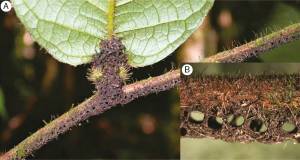Table of Contents
Group 8
<html><font size=6 face=“Arial”>Trappers vs Troopers: A fascinating system of Ants, Plant and Fungi</font></html>
Wiki site of the practical exercise of the IX Southern-Summer School on Mathematical Biology.
Here you will find the exercise assignment and the group's products.
If you are a group member login to edit this page, create new pages from it, and upload files.
Introduction
Many ants and plants engage in mutualistic interactions where plants provide resources to ants, such as food (in the form of extra-floral nectar or food bodies) and shelter (such as hollow stems and domatia) in exchange for protection against natural enemies. Ants protect plants from natural enemies by capturing herbivores and removing other natural enemies, such as competing and parasitic plants.

Two species of ants coexist (Allomerus octoarticulatus and A. decemarticulatus) in French Guinea with two distinct strategies regarding the protection they provide to their host plant. Their host plant (Hirtella physophora) provide the ants with nesting cavities, so-called domatia, in exchange for protection from herbivory (left photos of domatia and trapping from Annals of Botanic Office and Forest Floor Narrative).
The two strategies are:
i) The typical strategy of foraging on leaves, stems and trunk, actively searching for herbivores.

ii) The innovative strategy of using galleries for prey capture: the ants cut plant 'hairs' (trychomes) and bind them with a fungi that they grow to build galleries over the plant bark (Dejean et al 2005). The hollow porous tubes are filled with ants ready to ambush. Unsuspecting insects land on the trap and quickly become overwhelmed by the voracious invertebrates. Also the fungus used to build the galleries improves nutrient uptake by the host plant.
However, because of a limited worker force in their colonies, the prey capture behaviour of the ants results in a trade-off between the strategies of patrolling the foliage and ambushing prey in the galleries, which has a cascading effect on the fitness of all of the partners. The quantification of partners' traits and effects showed that the two ant species differed in their mutualistic investment ratios.
Less investment in the galleries (i.e. in fungal cultivation) translated into more benefits for the plant in terms of less herbivory and higher growth rates and vice-versa. However, the greater vegetative growth of the plants did not produce a positive fitness effect for the better mutualistic ant species in terms of colony size and production of reproductive individuals nor was the mutualism compensated by the wider dispersal of its queens.
In a nutshell: this tripartite relationship is fascinating! The plants receive nutrients and protection from the ants, while the ants get a place to live. The ants help to disperse and propagate the fungus, while the fungus helps hold the trapping structure together. The fungus also gets a place to live provided by the plants, and in turn, efficiently transfers nutrients from ant waste into the plant.
Assignment
Propose a mathematical model to investigate mutualistic investment, its potential trade-offs and their consequences for the persistence of ant species coexistence in this tripartite interaction involving a myrmecophyte (plant), two ant species which compete to occupy its domatia and a fungus that ants cultivate.
Suggested questions
- Is the coexistence of the two ant species possible?
- Will the scenario proposed by Orivel et al. lead to competitive exclusion, as proposed by the authors ?
- Is there an optimal proportion of the two strategies in the worker force? (A proportion that leads to the greatest ant population, or leads to the greatest growth rates…)
Further well-grounded questions from the group are welcome.
References
Jérôme Orivel, Pierre-Jean Malé, Jérémie Lauth, Olivier Roux, Frédéric Petitclerc, Alain Dejean and Céline Leroy. Trade-offs in an ant–plant–fungus mutualism 284 Proc. R. Soc. B. 2019.http://doi.org/10.1098/rspb.2016.1679.
Leroy, C., Séjalon‐Delmas, N., Jauneau, A., Ruiz‐González, M.‐X., Gryta, H., Jargeat, P., Corbara, B., Dejean, A. and Orivel, J. Trophic mediation by a fungus in an ant–plant mutualism. Journal of Ecology, 99: 583-590. 2011. https://doi.org/10.1111/j.1365-2745.2010.01763.x.
Dejean, Alain; Solano, Pascal J., Ayroles, Julien; Corbara, Bruno and Orivel, Jérôme Arboreal. Ants build traps to capture prey. Nature volume 434, pg. 973 (2005). https://www.nature.com/articles/434973a.
